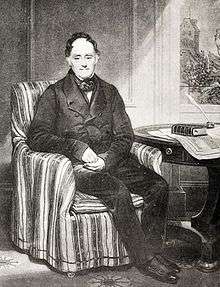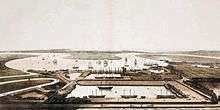George Green (shipbuilder)
George Green (1767 – 21 February 1849) was a wealthy philanthropist with a shipyard in Blackwall, London.


Green served his shipbuilding apprenticeship with John Perry at Blackwall Yard, one of the biggest private shipyards in the world. He married Perry's daughter Sarah in 1796; they had five children, all of whom died young except for a son named Richard. Sarah died in 1805, not yet 30. George Green remarried Elizabeth Unwin, and with her had another six children.[1] Two of their sons, Henry and Frederick, followed him into the family business, as did Richard. Henry completed his apprenticeship and became yard supervisor in 1822. Fredrick set up Frederick Green and Co., handling passengers and cargoes. After George retired in 1838, Richard, the eldest, took overall direction, including managing the ships.[2]
George Green contributed to many philanthropic causes in Poplar and Blackwall, notably the architecturally significant Trinity Independent Chapel and its associated "minister's house, sailors' home, schools, and almshouses", according to the Survey of London.[3] He endowed George Green's School (1828), which was rebuilt as the George Green Centre at Island Gardens in 1974–1978. The school maintains its maritime connection, and is supported by the Worshipful Company of Shipwrights.[4] The Sailors' Home (later Board of Trade offices and other uses, converted into flats in the 1980s) was built at 133 East India Dock Road and opened in 1841. It provided 200 beds of model accommodation, caring for the crews of his ships in between their voyages, protecting them from, among other things, the danger of the Crimping System (being Shanghaied). Unusually for its time, the Sailors' Home was racially integrated[5] (see Lascar).
Green was buried at St Matthias Old Church.[6]
| Wikimedia Commons has media related to George Green (shipbuilder). |
References
- Green, Henry (1881). Chronicles of Blackwall Yard. Whitehead, Morris and Lowe. p. 112.
Pages 112
- "The Green Blackwall Collection". Royal Museums Greenwich. Archived from the original on 17 February 2014. Retrieved 9 September 2012.
- "George Green's School - The Worshipful Company of Shipwrights". Shipwrights.co.uk. Retrieved 7 September 2013.
- Kverndal, Roald (1986). Seamen's Missions: Their Origin and Early Growth. William Carey Library. p. 378.
- Fuller, Tony (1998). Memorial Inscriptions at the East India Chapel, Poplar. Hornchurch: Armenians in India Press.